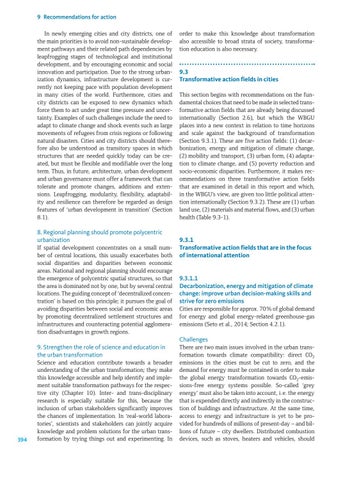9 Recommendations for action
In newly emerging cities and city districts, one of the main priorities is to avoid non-sustainable development pathways and their related path dependencies by leapfrogging stages of technological and institutional development, and by encouraging economic and social innovation and participation. Due to the strong urbanization dynamics, infrastructure development is currently not keeping pace with population development in many cities of the world. Furthermore, cities and city districts can be exposed to new dynamics which force them to act under great time pressure and uncertainty. Examples of such challenges include the need to adapt to climate change and shock events such as large movements of refugees from crisis regions or following natural disasters. Cities and city districts should therefore also be understood as transitory spaces in which structures that are needed quickly today can be created, but must be flexible and modifiable over the long term. Thus, in future, architecture, urban development and urban governance must offer a framework that can tolerate and promote changes, additions and extensions. Leapfrogging, modularity, flexibility, adaptability and resilience can therefore be regarded as design features of ‘urban development in transition’ (Section 8.1).
8. Regional planning should promote polycentric urbanization If spatial development concentrates on a small number of central locations, this usually exacerbates both social disparities and disparities between economic areas. National and regional planning should encourage the emergence of polycentric spatial structures, so that the area is dominated not by one, but by several central locations. The guiding concept of ‘decentralized concentration’ is based on this principle; it pursues the goal of avoiding disparities between social and economic areas by promoting decentralized settlement structures and infrastructures and counteracting potential agglomeration disadvantages in growth regions.
394
9. Strengthen the role of science and education in the urban transformation Science and education contribute towards a broader understanding of the urban transformation; they make this knowledge accessible and help identify and implement suitable transformation pathways for the respective city (Chapter 10). Inter- and trans-disciplinary research is especially suitable for this, because the inclusion of urban stakeholders significantly improves the chances of implementation. In ‘real-world laboratories’, scientists and stakeholders can jointly acquire knowledge and problem solutions for the urban transformation by trying things out and experimenting. In
order to make this knowledge about transformation also accessible to broad strata of society, transformation education is also necessary.
9.3 Transformative action fields in cities This section begins with recommendations on the fundamental choices that need to be made in selected transformative action fields that are already being discussed internationally (Section 2.6), but which the WBGU places into a new context in relation to time horizons and scale against the background of transformation (Section 9.3.1). These are five action fields: (1) decarbonization, energy and mitigation of climate change, (2) mobility and transport, (3) urban form, (4) adaptation to climate change, and (5) poverty reduction and socio-economic disparities. Furthermore, it makes recommendations on three transformative action fields that are examined in detail in this report and which, in the WBGU’s view, are given too little political attention internationally (Section 9.3.2). These are (1) urban land use, (2) materials and material flows, and (3) urban health (Table 9.3-1).
9.3.1 Transformative action fields that are in the focus of international attention
9.3.1.1 Decarbonization, energy and mitigation of climate change: improve urban decision-making skills and strive for zero emissions Cities are responsible for approx. 70 % of global demand for energy and global energy-related greenhouse-gas emissions (Seto et al., 2014; Section 4.2.1). Challenges There are two main issues involved in the urban transformation towards climate compatibility: direct CO2 emissions in the cities must be cut to zero, and the demand for energy must be contained in order to make the global energy transformation towards CO2-emissions-free energy systems possible. So-called ‘grey energy’ must also be taken into account, i. e. the energy that is expended directly and indirectly in the construction of buildings and infrastructure. At the same time, access to energy and infrastructure is yet to be provided for hundreds of millions of present-day – and billions of future – city dwellers. Distributed combustion devices, such as stoves, heaters and vehicles, should
